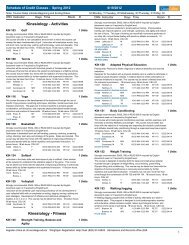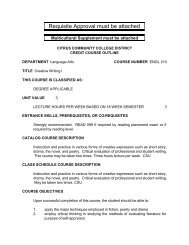Citrus College Catalog 2009-2010 (ver. 10/22
Citrus College Catalog 2009-2010 (ver. 10/22
Citrus College Catalog 2009-2010 (ver. 10/22
You also want an ePaper? Increase the reach of your titles
YUMPU automatically turns print PDFs into web optimized ePapers that Google loves.
California State Uni<strong>ver</strong>sity<br />
The California State Uni<strong>ver</strong>sity is<br />
the nation's largest uni<strong>ver</strong>sity system,<br />
with 23 campuses, seven<br />
off-site campus centers, o<strong>ver</strong><br />
400,000 students, and 42,000<br />
faculty and staff. With campuses<br />
from Humboldt in the north to<br />
San Diego in the south, the CSU<br />
is renowned for the quality of its<br />
teaching and for its job-ready<br />
graduates.<br />
The 23 CSU campuses are:<br />
Bakersfield<br />
Channel Islands<br />
Chico<br />
Dominguez Hills<br />
Fresno<br />
Fullerton<br />
East Bay<br />
Humboldt<br />
Los Angeles<br />
Long Beach<br />
Maritime Academy<br />
Monterey Bay<br />
Northridge<br />
Pomona<br />
Sacramento<br />
San Bernardino<br />
San Diego<br />
San Francisco<br />
San Jose<br />
San Luis Obispo<br />
San Marcos<br />
Sonoma<br />
Stanislaus<br />
While part of the CSU system,<br />
each campus has a unique identity.<br />
CSU campuses have distinct<br />
student populations and programs,<br />
but all share the same<br />
mission to provide high-quality,<br />
affordable higher education that<br />
meets the e<strong>ver</strong>-changing needs of<br />
the people of California.<br />
CSU offers nearly 1,800 bachelor's<br />
and master's degree programs<br />
in 240 subject areas. Many<br />
of these programs are offered in<br />
the late afternoon and evenings<br />
for students who work during the<br />
day.<br />
98<br />
The California State Uni<strong>ver</strong>sity<br />
seeks to assist California community<br />
college students in preparing<br />
for transfer and in completing<br />
their baccalaureate degree. Each<br />
year, nearly 60,000 transfer students<br />
enter the CSU system. The<br />
key to a successful transfer is<br />
early planning to ensure that students<br />
complete courses to meet<br />
the admission, general education,<br />
and lower division major preparation<br />
requirements.<br />
O<strong>ver</strong> two-thirds of students who<br />
receive a baccalaureate degree<br />
from the CSU begin their educational<br />
program at a California<br />
community college (CCC). The<br />
CSU guarantees admission to its<br />
system to all CCC students who<br />
meet CSU upper division transfer<br />
admission requirements. Students<br />
who enter a California community<br />
college as freshmen and then<br />
transfer to the CSU are as successful<br />
academically as those students<br />
who enter CSU directly<br />
from high school as freshmen.<br />
Undergraduate Transfers<br />
The California State Uni<strong>ver</strong>sity<br />
generally considers an undergraduate<br />
transfer student as one who<br />
has enrolled in a community college<br />
or uni<strong>ver</strong>sity other than a<br />
CSU following high school graduation.<br />
Students with fewer than 60<br />
transferable semester units are<br />
considered lower division transfers.<br />
Students with 60 transferable<br />
semester units are<br />
considered upper division<br />
transfers.<br />
Admission Priority<br />
Among the highest priorities for<br />
admission to CSU are California<br />
community college transfer students<br />
who have completed the<br />
first two years of the baccalaureate<br />
program, including transfer<br />
students applying for impacted<br />
programs. Students will be considered<br />
as having achieved junior<br />
class level standing once they<br />
have completed at least 60 semester<br />
baccalaureate level units.<br />
Unit Requirements<br />
An applicant who completes<br />
fewer than 60 semester units of<br />
college credit is considered a<br />
lower division transfer student.<br />
The student is admitted to a campus<br />
as an undergraduate transfer<br />
if the campus to which the student<br />
applies admits lower division<br />
transfer students.<br />
Due to enrollment pressures,<br />
some CSU campuses do no<br />
admit lower division transfers<br />
so that more upper division transfers<br />
can be accommodated. Having<br />
fewer than 60 units at the<br />
point of transfer may affect eligibility<br />
for registration priority at<br />
CSU campuses and may affect the<br />
student's financial aid status.<br />
A maximum of 70 semester units<br />
earned at community colleges<br />
may be transferred to CSU.<br />
Community college coursework<br />
completed above the 70 units<br />
may be used to meet GE and<br />
major preparation requirements<br />
even if the units will not count toward<br />
the baccalaureate degree.<br />
Lower Division Admission<br />
Requirements<br />
Transfer applicants with fewer<br />
than 60 semester units must have<br />
a grade point a<strong>ver</strong>age of 2.0 (C)<br />
or better in all transferable units<br />
attempted, be in good standing at<br />
the last college or uni<strong>ver</strong>sity attended,<br />
and meet any one of the<br />
following eligibility standards.<br />
Transfer Based on Current<br />
Admission Criteria<br />
The applicant meets the freshman<br />
admission requirements in effect<br />
for the term for which application<br />
is being made;<br />
-OR-<br />
CITRUS COLLEGE CATALOG <strong>2009</strong> • <strong>20<strong>10</strong></strong> www.citruscollege.edu
















